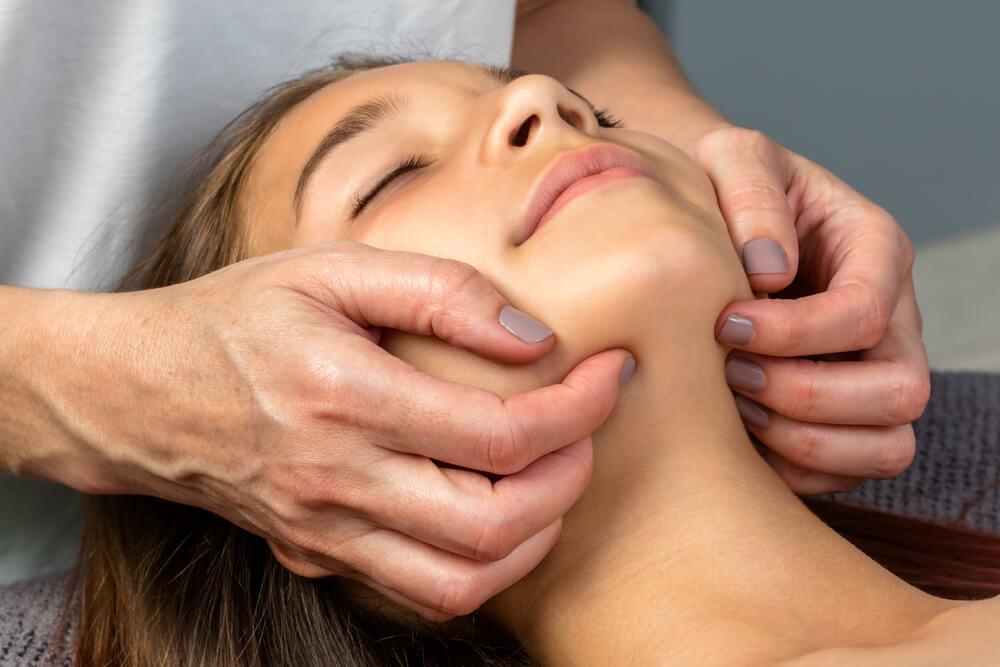The temporomandibular joint (TMJ) hinges on our bottom jaw to the base of our skull. It allows us to open our mouths for chewing, laughing and talking. When the temporomandibular joint becomes inflamed, the result is TMJ dysfunction. This condition affects anywhere from 5% to 12% of people in the U.S. It can cause pain and difficulty when using the joint to perform various activities, like eating and talking. Are you experiencing the symptoms of TMJ dysfunction? Massage may be the right treatment solution for your symptoms.
Call Us TodayWhat are the causes of TMJ dysfunction?
While the exact causes of TMJ dysfunction aren’t well understood, there are many conditions and factors that experts believe can lead a person to develop this condition. These factors include:
- Excessive overuse of the jaw joints — One of the top causes of TMJ dysfunction is excessive or repetitive movements of the jaw joints. Overusing the jaw can irritate the jaw joints and make moving them feel challenging or uncomfortable to do. Causes of overuse usually include chewing gum, biting your nails or chewing on various items.
- Arthritis in the jaw joints — Another possible cause of TMJ dysfunction is joint disease or joint pain. Arthritis can develop anywhere in the body, particularly in the joints. When arthritis develops in the jaw joint, it can lead to dysfunction and discomfort in the temporomandibular joint. Arthritis types most commonly affecting the TMJ include osteoarthritis and rheumatoid arthritis.
- The jaw joint disc moving out of alignment — There is a disc that sits in the joint socket, and when this disc moves out of place, it can cause issues with function and pain. The jaw may appear abnormally formed to the observer, creating difficulty when opening the mouth.
- Excessive force or trauma to the jaw joints — An injury to the jaw or excessive force that moves the jaw out of place can be another reason somebody develops TMJ dysfunction. Injury to the jaw joint can cause inflammation, limited range of motion, pain, and unusual popping or clicking sounds.
- Grinding or clenching the teeth — Someone who grinds or clenches their teeth regularly is likely to develop TMJ pain and dysfunction. Grinding or clenching the teeth can lead to overuse of the jaw and can cause inflammation to develop. It may also cause the jaw joint to move out of its natural alignment.
- Cervical spine dysfunction — Many people with tightness/stiffness in the cervical spine/neck (particularly the upper cervical spine) can present with issues in the TMJ, as mobility in these areas go hand in hand for appropriate mechanics at the TMJ.
What benefits can manual therapy or massage provide someone with TMJ dysfunction?
Manual therapy is a type of treatment, similar to massage, that a physical therapist can perform to alleviate many of the symptoms of TMJ dysfunction. Some of the benefits of this form of massage include:
- Reducing pain — One of the top benefits of manual therapy or massage is decreased pain levels. Massaging the soft tissue around the jaw can promote circulation around the joint area and encourage faster healing. Massaging the jaw can also reduce tension in the muscle, which may contribute to pain around the joint.
- Decreasing swelling — Just as massage can reduce pain levels by increasing circulation to a specific area, it can also reduce swelling. Promoting circulation around the jaw can help decrease the swelling that may be causing limited function and discomfort due to TMJ dysfunction.
- Increasing joint mobility — With reduced swelling and pain, the joint can be made more mobile. A physical therapist can gently move your jaw joint during a manual therapy session and massage away muscle knots. Mobilization to the cervical spine can also improve mechanics at the TMJ.
- Reducing scar tissue — One more benefit of massage is that it can reduce any excess scar tissue that may be contributing to TMJ dysfunction. Oftentimes, when large amounts of scar tissue build, it can cause stiffness and pain. Massage can break up these areas of scar tissue so that your jaw function can begin to improve.
Let Advent Physical Therapy improve your TMJ dysfunction with manual therapy and massage
If you’re experiencing pain that occurs when you use your jaw to chew or bite, our physical therapists can help. At Advent Physical Therapy, we use a variety of evidence-based PT treatments, like manual therapy and massage, to help each one of our patients with TMJ dysfunction in their physical condition.
Our patients’ health and wellness are our first priority at Advent Physical Therapy. We understand how much getting back your functionality and comfort means to you. When it comes to improving your TMJ dysfunction, we’ve got you covered. Our office has some of the best massage physical therapists who want to help you reach your unique goals. We’re a team-oriented group of professionals who work with each of our patients jointly to create the best outcomes for all.
We can create a treatment plan to optimize your health, even years down the line. We value building relationships with our patients and helping them prevent pain and injury from occurring. If you’d like to move forward with treatment from us, let us provide a free screening to help us address your health.
Call Us TodayContact our team today for more information on how we can help with TMJ dysfunction through massage or to schedule an initial appointment with us.

